Columbia, South Carolina Blood Testing Facilities
 Represents a LabCorp blood testing facility
Represents a LabCorp blood testing facility Represents a Quest Diagnostics blood testing facility
Represents a Quest Diagnostics blood testing facility

Nearby Labcorp Blood Testing facilities:
- Labcorp Center Distance: 0 m, 2100 Gervais St Ste B, Columbia, Richland County, SC, 29204
- Labcorp Center Distance: 5 m, 2 Southern Ct, West Columbia, Lexington County, SC, 29169
- Labcorp Center Distance: 9 m, 120 Highland Ctr Dr Ste 130B, Columbia, Richland County, SC, 29203
- Labcorp Center Distance: 30 m, 1350 Haile St, Camden, Kershaw County, SC, 29020
- Labcorp Center Distance: 34 m, 116 Stagecoach Ln, Orangeburg, Orangeburg County, SC, 29118
- Labcorp Center Distance: 37 m, 144 Garrett St Ste B, Sumter, Sumter County, SC, 29150
- Labcorp Center Distance: 38 m, 2669 Kinard St, Newberry, Newberry County, SC, 29108
- Labcorp Center Distance: 51 m, 800 W Meeting St, Lancaster, Lancaster County, SC, 29720
- Labcorp Center Distance: 53 m, 430 Society Hill Drive, Aiken, Aiken County, SC, 29803
- Labcorp Center Distance: 65 m, 1111 Edgefield Street, Greenwood, Greenwood County, SC, 29646
- Labcorp Center Distance: 67 m, 2460 India Hook Rd Ste 101, Rock Hill, York County, SC, 29732
- Labcorp Center Distance: 68 m, Highway 278, Fairfax, Other, SC, 29827
- Labcorp Center Distance: 70 m, 1219 West Wheeler Pkwy Suite D, Augusta, Richmond County, GA, 30909
- Labcorp Center Distance: 71 m, 425 N. Belair Rd Suite 2, Evans, Columbia County, GA, 30809
- Labcorp Center Distance: 72 m, 711 Saluda Dr, Florence, Florence County, SC, 29501
- Labcorp Center Distance: 73 m, 15830 Ballantyne Med Pl Ste140, Charlotte, Mecklenburg County, NC, 28277
- Labcorp Center Distance: 76 m, 10512 Park Rd Ste 107, Charlotte, Mecklenburg County, NC, 28210
- Labcorp Center Distance: 77 m, 501 Robertson Blvd, Walterboro, Colleton County, SC, 29488
- Labcorp Center Distance: 79 m, 1500 Matthews Twnshp Pkwy1147, Matthews, Mecklenburg County, NC, 28105
- Labcorp Center Distance: 82 m, 1530 N Limestone St, Gaffney, Cherokee County, SC, 29340
- Labcorp Center Distance: 83 m, 300 Billingsley Rd Ste 200A, Charlotte, Mecklenburg County, NC, 28211
- Labcorp Center Distance: 84 m, 391 Serpentine Dr Ste 101, Spartanburg, Spartanburg County, SC, 29303
- Labcorp Center Distance: 87 m, 105A Harth Pl, Summerville, Dorchester County, SC, 29485
- Labcorp Center Distance: 88 m, 640 Summit Crossing Pl Ste 206, Gastonia, Gaston County, NC, 28054
- Labcorp Center Distance: 89 m, 2850 Tricom Street, North Charleston, Charleston County, SC, 29406
- Labcorp Center Distance: 92 m, 8401 Medical Plaza Dr. Ste 140, Charlotte, Mecklenburg County, NC, 28262
- Labcorp Center Distance: 93 m, 215 Mims Rd, Sylvania, Screven County, GA, 30467
- Labcorp Center Distance: 94 m, 135 Commonwealth Dr Ste 150, Greenville, Greenville County, SC, 29615
- Labcorp Center Distance: 95 m, 25 Woods Lake Rd Ste 222, Greenville, Greenville County, SC, 29607
- Labcorp Center Distance: 97 m, 10030 Gilead Road Ste 100-B, Huntersville, Mecklenburg County, NC, 28078
- Labcorp Center Distance: 98 m, 3825 Faber Place Dr, North Charleston, Charleston County, SC, 29405
- Labcorp Center Distance: 99 m, 120 Gordon St, Washington, Wilkes County, GA, 30673
Nearby Quest Blood Testing facilities:
- Quest Center Distance: 1 m, 3010 Farrow Rd, Columbia, Richland County, SC, 29203-7603
- Quest Center Distance: 70 m, 1109 Medical Center Drive, Augusta, Richmond County, GA, 30909-6647
- Quest Center Distance: 75 m, 11111 Carmel Commons Blvd, Charlotte, Mecklenburg County, NC, 28226-4075
- Quest Center Distance: 83 m, 3541 Randolph Rd Ste 110, Charlotte, Mecklenburg County, NC, 28211-1082
- Quest Center Distance: 86 m, 1203 Old Trolley Rd, Summerville, Dorchester County, SC, 29485-5296
- Quest Center Distance: 93 m, 430 Roper Mountain Road, Greenville, Greenville County, SC, 29615-4243
South Carolina Hormone Replacement Services
The Conscious Evolution Institute is your top source for doctor-prescribed, pharmaceutical grade Hormone Treatments in the state of South Carolina. Our licensed medical clinic has figured out the perfect way to streamline and speed up the process of hormone diagnosis so that you can experience Hormone Restoration quickly and easily, all while ensuring that the treatment that we recommend is the perfect option for you.
The whole process is simple. Just fill out the form on our website or give us a call, and we will set up an appointment with a local physician in your area who will perform the necessary check-up and draw the blood sample we will use to gauge your health and hormone status. As soon as the information reaches our office, our clinically trained and board certified HRT Doctors will look over your diagnostic data and plan a Hormone Replacement Therapy regimen specifically designed to meet your unique needs.
South Carolina HGH Injections
Do you know what Human Growth Hormone can do for you? If you are over the age of thirty, and are suffering from clinical HGH Deficiency, Growth Hormone Replacement Therapy can restore the normal, optimal function of the human body.
Symptoms of HGH Deficiency include lack of energy, reduced exercise capacity, increased weight gain around the midsection, cholesterol imbalance, high triglycerides, sleeping difficulties, and foggy memory. Physician-Monitored Recombinant Growth Hormone Therapy can restore your body's natural and youthful GH Balance, slowing down or reversing many of the symptoms of premature aging.
South Carolina Sermorelin Therapy
There is more than one way to treat Adult-Onset GH Deficiency, however. Another highly effective treatment is called Sermorelin Acetate. This medication is a functional analogue of a hormone made by the human body known as Growth Hormone-Releasing Hormone. GH-RH is released by the hypothalamus and flows to the pituitary where it stimulates HGH to be released in healthy concentrations.
South Carolina Low-T
If you are a man 30 years or over that is experiencing sexual decline, before you turn to Cialis or other Erectile Dysfunction pills, get tested for Testosterone Deficiency. The most noticeable symptoms of Low-T are sexual, but this form of Hormone Deficiency also contributes to a number of other symptoms that can reduce your quality of life and significantly increase your mortality risk.
Men with Age-Related Low-T are more at risk for a number of conditions, including hypertension, stroke, heart attack, heart disease, and diabetes, and they also lose muscle mass and gain weight. All of this can be mitigated by Testosterone Replacement Therapy. By replacing your waning Testosterone Levels via patch, implant, cream, or injection, you can restore youthful Hormone Balance and safeguard your health from the perils of Low-T.
South Carolina HCG Therapy
The Conscious Evolution Institute can help you lose weight too! If you are obese or just have issues getting to your ideal weight, HCG Injections can help you melt away the pounds and overcome the barrier created by hunger.
The HCG Diet is a specially-designed plan which can help you lose 5+ pounds per week without being overwhelmed by hunger, and it also triggers the body to burn adipose fat more efficiently, the most troublesome and dangerous form of fat.
Major Cities in South Carolina
Columbia
Columbia is both the most highly populated city in South Carolina as well as the capital of the state. Columbia is located at the heart of the state, and goes by the nicknames The City of Dreams and The Capital of Southern Hospitality. Columbia is home to the University of South Carolina.
Columbia has a large number of cultural institutions, including the McKissick Museum, the Columbia Museum of Art, and the South Carolina State Museum. Columbia has a complex economy, and some of its largest employers are Blue Cross Blue Shield, Palmetto Health, Fort Jackson, and the Computer Sciences Corporation.
Charleston
Charleston is one of the premier tourist attractions of South Carolina. It is one of the oldest cities in the south, and is the oldest in South Carolina. It is also the second most populous city in the state. The city is known by the nickname, The Holy City.
Charleston is a popular tourist attraction because of its immense history and culture. It has a large number of old and beautifully preserved buildings, some of the best restaurants in America, and is considered one of the friendliest cities of the nation.
North Charleston
North Charleston is located directly inland of Charleston, and is the third most populous city in the state of South Carolina. North Charleston is a very new city, only founded in 1972, as people moved into the area for the opportunities afforded in Charleston.
North Charleston's economy revolves largely around Boeing Aircraft, and is among only 4 places in the entire world where wide-framed aircraft are manufactured and assembled. North Charleston is a modern industrial city, and other businesses in the area include Cummins Turbo and Venture Aerobearings.
Mount Pleasant
Mount Pleasant is the second largest suburb of Charleston, South Carolina, and is the fourth most populous city in the state. Mount Pleasant and Charleston face one another, divided by the Cooper River. Mount Pleasant is home to a few important cultural landmarks, including the USS Yorktown and Patriot's Point. Mount Pleasant has a number of beautiful parks, including Future Park, Palmetto Islands County Park, and Mt. Pleasant Pier.
Rock Hill
Rock Hill is located in the north-central portion of South Carolina, and is the fifth most populous city in the state. Rock Hill is a suburb of Charlotte, North Carolina which lies just across the border. The city once had a strong textile industry, but now is adapting and developing stronger manufacturing and retail sectors. Among the largest employers in the city are Carolina Energy, Amida Industries, and 3D Systems.
All About Columbia, South Carolina Geographic Area
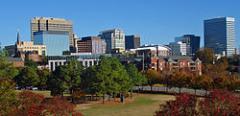
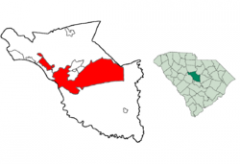
Columbia is the state capital and largest city in the U.S. state of South Carolina. The population was 129,272 according to the 2010 census. The 2011 United States Census Estimates put the city at 130,591. Columbia is the county seat of Richland County, but a portion of the city extends into neighboring Lexington County. The city is the center of a metropolitan statistical area of 767,598, the largest within the state. The name Columbia was a poetic term for the Americas derived from Christopher Columbus.
Located 13 miles (21 km) northwest of South Carolina's geographic center, Columbia is the primary city of the Midlands region of South Carolina, which comprises several counties in the central portion of the state. The city lies at the confluence of two rivers, the Saluda and the Broad, which merge at Columbia to form the Congaree River. CNNMoney.com named Columbia as one of America's 25 best places to retire, and U.S. News & World Report ranked the city sixth on its 2009 America's Best Affordable Places to Retire list.
From the creation of Columbia by the South Carolina General Assembly in 1786, the site of Columbia was important to the overall development of the state. The Congarees, a frontier fort on the west bank of the Congaree River, was the head of navigation in the Santee River system. A ferry was established by the colonial government in 1754 to connect the fort with the growing settlements on the higher ground on the east bank.
Like many other significant early settlements in colonial America, Columbia is on the fall line from the Appalachian Mountains. The fall line is the spot where a river become unnavigable when sailing upstream and where falling water downstream cannot power a mill.
State Senator John Lewis Gervais of Ninety Six introduced a bill that was approved by the legislature on March 22, 1786, to create a new state capital. There was considerable argument over the name for the new city. (UTC) According to published accounts, Senator Gervais said he hoped that "in this town we should find refuge under the wings of COLUMBIA", for that was the name which he wished it to be called. One legislator insisted on the name Washington, but Columbia won out by a vote of 11-7 in the state senate.
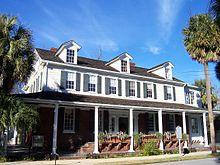
The site was chosen as the new state capital in 1786, due to its central location in the state. The State Legislature first met there in 1790. After remaining under the direct government of the legislature for the first two decades of its existence, Columbia was incorporated as a village in 1805 and then as a city in 1854. Columbia received a large stimulus to development when it was connected in a direct water route to Charleston, by the Santee Canal. This canal connected the Santee and Cooper Rivers in a 22-mile (35 km) section. It was first chartered in 1786 and completed in 1800, making it one of the earliest canals in the United States. With increased railroad traffic, it ceased operation around 1850.
The commissioners designed a town of 400 blocks in a two-mile (3 km) square along the river. The blocks were divided into lots of 0.5 acres (2,000 m2) and sold to speculators and prospective residents. Buyers had to build a house at least 30 feet (9.1 m) long and 18 feet (5.5 m) wide within three years or face an annual 5% penalty. The perimeter streets and two through streets were 150 feet (46 m) wide. The remaining squares were divided by thoroughfares 100 feet (30 m) wide. The width was determined by the belief that dangerous and pesky mosquitoes could not fly more than 60 feet (18 m) without dying of starvation along the way. Columbians still enjoy most of the magnificent network of wide streets.
The commissioners comprised the local government until 1797 when a Commission of Streets and Markets was created by the General Assembly. Three main issues occupied most of their time: public drunkenness, gambling, and poor sanitation.
As one of the first planned cities in the United States, Columbia began to grow rapidly. Its population was nearing 1,000 shortly after the turn of the 18h to 19th century.
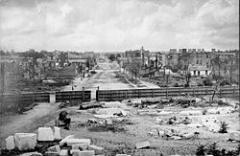
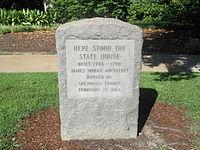
In 1801, South Carolina College (now the University of South Carolina) was founded in Columbia. The original building survives. The city was chosen as the site of the institution in part to unite the citizens of the Upcountry and the Lowcountry and to discourage the youth from migrating to England for their higher education. At the time, South Carolina sent more young men to England than did any other state. The leaders of South Carolina wished to monitor the progress and development of the school; for many years after the founding of the university, commencement exercises were held in December while the state legislature was in session.
Columbia received its first charter as a town in 1805. An intendant and six wardens would govern the town. John Taylor, the first elected intendant, later served in both houses of the General Assembly, both houses of Congress, and eventually as governor. By 1816, there were 250 homes in the town and a population of more than one thousand. Columbia became chartered as a city in 1854, with an elected mayor and six aldermen. Two years later, Columbia had a police force consisting of a full-time chief and nine patrolmen. The city continued to grow at a rapid pace, and throughout the 1850s and 1860s Columbia was the largest inland city in the Carolinas. Railroad transportation served as a significant cause of population expansion in Columbia during this time. Rail lines that reached the city in the 1840s primarily transported cotton bales, not passengers. Cotton was the lifeblood of the Columbia community; in 1850 virtually all of the city's commercial and economic activity was related to cotton.
"In 1830, approximately 1,500 slaves lived and worked in Columbia; this population grew to 3,300 by 1860. Some members of this large enslaved population worked in their masters ao households. Masters also frequently hired out slaves to Columbia residents and institutions, including South Carolina College. Hired-out slaves sometimes returned to their owner aos home daily; others boarded with their temporary masters". During this period, "legislators developed state and local statutes to restrict the movement of urban slaves in hopes of preventing rebellion. Although various decrees established curfews and prohibited slaves from meeting and from learning to read and write, such rulings were difficult to enforce". Indeed, "several prewar accounts note that many Columbia slaves were literate; some slaves even conducted classes to teach others to read and write". As well, "many slaves attended services at local Baptist, Presbyterian, and Methodist churches, yet some struggled to obtain membership in these institutions".
Columbia's First Baptist Church hosted the South Carolina Secession Convention on December 17, 1860. The delegates drafted a resolution in favor of secession, 159-0. Columbia's location made it an ideal location for other conventions and meetings within the Confederacy. During the Civil War, bankers, railroad executives, teachers, and theologians often met in the city to discuss certain matters.[vague]
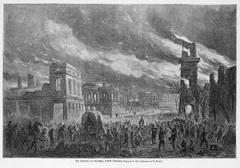
On February 17, 1865, in the last months of the Civil War, much of Columbia was destroyed by fire while being occupied by Union troops under the command of General William Tecumseh Sherman. According to legend, Columbia's First Baptist Church barely missed being torched by Sherman's troops. The soldiers marched up to the church and asked the groundskeeper if he could direct them to the church where the declaration of secession was signed. The groundskeeper lied, and directed the men to the nearby Washington Street Methodist Episcopal Church, South; thus, the historic landmark was saved from destruction by Union soldiers, and the groundskeeper preserved his employment at the cost of another.
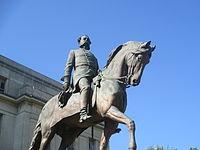
Controversy surrounding the burning of the city started soon after the war ended. General Sherman blamed the high winds and retreating Confederate soldiers for firing bales of cotton, which had been stacked in the streets. General Sherman denied ordering the burning, though he did order militarily significant structures, such as the Confederate Printing Plant, destroyed. Firsthand accounts by local residents, Union soldiers, and a newspaper reporter offer a tale of revenge by Union troops for Columbia's and South Carolina's pivotal role in leading Southern states to secede from the Union. Still other accounts portray it as mostly the fault of the Confederacy. Today, tourists can follow the path General Sherman's army took to enter the city and see structures or remnants of structures that survived the fire.
During Reconstruction, Columbia became the focus of considerable attention. Reporters, journalists, travelers, and tourists flocked to South Carolina's capital city to witness a Southern state legislature whose members included former slaves. The city also made somewhat of a rebound following the devastating fire of 1865; a mild construction boom took place within the first few years of Reconstruction, and repair of railroad tracks in outlying areas created jobs for area citizens.
Following reconstruction, the Columbia Music Festival Association (CMFA) was established in 1897, by Mayor William McB. Sloan and the alderman of the City of Columbia. It was headquartered in the Opera House on Main Street, which was also City Hall. Its role was to book and manage concerts and events in the opera house for the city.
The first few years of the 20th century saw Columbia emerge as a regional textile manufacturing center. In 1907, Columbia had six mills in operation: Richland, Granby, Olympia, Capital City, Columbia, and Palmetto. Combined, they employed over 3,400 workers with an annual payroll of $819,000, giving the Midlands an economic boost of over $4.8 million. Columbia had no paved streets until 1908, when 17 blocks of Main Street were surfaced. There were, however, 115 publicly maintained street crossings at intersections to keep pedestrians from having to wade through a sea of mud between wooden sidewalks. As an experiment, Washington Street was once paved with wooden blocks. This proved to be the source of much local amusement when they buckled and floated away during heavy rains. The blocks were replaced with asphalt paving in 1925.
The years 1911 and 1912 were something of a construction boom for Columbia, with $2.5 million worth of construction occurring in the city. These projects included the Union Bank Building at Main and Gervais, the Palmetto National Bank, a shopping arcade, and large hotels at Main and Laurel (the Jefferson) and at Main and Wheat (the Gresham). In 1917, the city was selected as the site of Camp Jackson, a U.S. military installation which was officially classified as a "Field Artillery Replacement Depot." The first recruits arrived at the camp on September 1, 1917.
In 1930, Columbia was the hub of a trading area with approximately 500,000 potential customers. It had 803 retail establishments, 280 of them being food stores. There were also 58 clothing and apparel outlets, 57 restaurants and lunch rooms, 55 filling stations, 38 pharmacies, 20 furniture stores, 19 auto dealers, 11 shoe stores, nine cigar stands, five department stores and one book store. Wholesale distributors located within the city numbered 119, with one-third of them dealing in food.
In 1934, the federal courthouse at the corner of Main and Laurel streets was purchased by the city for use as City Hall. Built of granite from nearby Winnsboro, Columbia City Hall is listed on the National Register of Historic Places. Designed by Alfred Built Millet, President Ulysses S. Grant's Federal architect, the building was completed in 1876. Millet, best known for his design of the Executive Office Building in Washington, D.C., had originally designed the building with a clock tower. Large cost overruns probably caused it to be left out. Copies of Mullet's original drawings can be seen on the walls of City Hall alongside historic photos of Columbia's beginnings.
Reactivated Camp Jackson became Fort Jackson in 1940, giving the military installation the permanence desired by city leaders at the time. The fort was annexed into the city in the fall of 1968, with approval from the Pentagon. In the early 1940s, shortly after the attacks on Pearl Harbor which began America's involvement in World War II, Lt. Colonel Jimmy Doolittle and his group of now-famous pilots began training for the Doolittle Raid over Tokyo at what is now Columbia Metropolitan Airport. They trained in B-25 Mitchell bombers, the same model as the plane that now rests at Columbia's Owens Field in the Curtiss-Wright hangar. The area's population continued to grow during the 1950s, having experienced a 40 percent increase from 186,844 to 260,828, with 97,433 people residing within the city limits of Columbia.
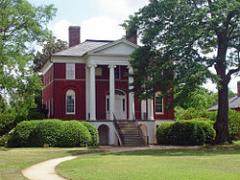
The 1940s saw the beginning of efforts to reverse Jim Crow laws and racial discrimination in Columbia. In 1945, a federal judge ruled that the city's black teachers were entitled to equal pay to that of their white counterparts. However, in years following, the state attempted to strip many blacks of their teaching credentials. Other issues in which the blacks of the city sought equality concerned voting rights and segregation (particularly regarding public schools). On August 21, 1962, eight downtown chain stores served blacks at their lunch counters for the first time. The University of South Carolina admitted its first black students in 1963; around the same time, many vestiges of segregation began to disappear from the city, blacks attained membership on various municipal boards and commissions, and a non-discriminatory hiring policy was adopted by the city. These and other such signs of racial progression helped earn the city the 1964 All-America City Award for the second time (the first being in 1951) and a 1965 article in Newsweek magazine lauded Columbia as a city that had "liberated itself from the plague of doctrinal apartheid."
Historic preservation has played a significant part in shaping Columbia into the city that it is today. The historic Robert Mills House was restored in 1967, which inspired the renovation and restoration of other historic structures such as the Hampton-Preston House and homes associated with President Woodrow Wilson, Maxcy Gregg, Mary Boykin Chesnut, and noted free black Celia Mann. In the early 1970s, the University of South Carolina initiated the refurbishment of its "Horseshoe". Several area museums also benefited from the increased historical interest of that time, among them the Fort Jackson Museum, the McKissick Museum on the campus of the University of South Carolina, and most notably the South Carolina State Museum, which opened in 1988.
Mayor Kirkman Finlay, Jr., was the driving force behind the refurbishment of Seaboard Park, now known as Finlay Park, in the historic Congaree Vista district, as well as the compilation of the $60 million Palmetto Center package, which gave Columbia an office tower, parking garage, and the Columbia Marriott, which opened in 1983. The year 1980 saw the Columbia metropolitan population reach 410,088 and in 1990 this figure had hit approximately 470,000.
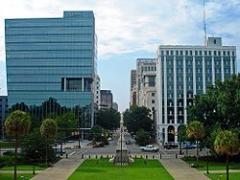
The 1990s and early 2000s saw revitalization in the downtown area. The Congaree Vista district along Gervais Street, once known as a warehouse district, became a thriving district of art galleries, shops, and restaurants. The Colonial Life Arena (formerly known as the Carolina Center) opened in 2002, and brought several big-named concerts and shows to Columbia. The Columbia Metropolitan Convention Center opened in 2004, and a new convention center hotel opened in September 2007. A public-private City Center Partnership has been formed to implement the downtown revitalization and boost downtown growth.

Columbia is located at 34 °0 a²2 a³N 81 °2 a²39 a³W / 34.00056 °N 81.04417 °W / 34.00056; -81.04417. One of Columbia's most interesting geographical features is its fall line, which is a boundary between an upland region and a coastal plain across which rivers from the upland region drop to the plain as falls or rapids. Columbia grew up at the fall line of the Congaree River, which is formed by the convergence of the Broad River and the Saluda River. The Congaree was the farthest inland point of river navigation. The energy of falling water also powered Columbia's early mills. The city has capitalized on this location which includes three rivers by christening itself "The Columbia Riverbanks Region". Columbia is located roughly halfway between the Atlantic Ocean and the Blue Ridge Mountains and sits at an elevation of around 292 ft (89 m).
Soils in Columbia are well drained in most cases, with grayish brown loamy sand topsoil. The subsoil may be yellowish red sandy clay loam (Orangeburg series), yellowish brown sandy clay loam (Norfolk series), or strong brown sandy clay (Marlboro series). All belong to the Ultisol soil order.
According to the United States Census Bureau, the city has a total area of 127.7 square miles (331 km2), of which 125.2 square miles (324 km2) is land and 2.5 square miles (6.5 km2) is water (1.96%). Approximately 2/3 of Columbia's land area, 81.2 square miles (210 km2), is contained within the Fort Jackson Military Installation, much of which consists of uninhabited training grounds. The actual inhabited area for the city is slightly more than 50 square miles (130 km2).
Columbia has a humid subtropical climate (Koppen Cfa), with mild winters, warm springs and autumns, and very hot and humid summers. The area averages 56 nights below freezing, but extended cold is rare. The city's current promotional slogan describes Columbia as "Famously Hot". Precipitation, at 48.3 inches (1,230 mm) annually, peaks in the summer months, and is the least during spring and fall. Snowfall averages 2.1 inches (5.3 cm), but most years receive no snowfall, as the median seasonal amount is 0. The city, like other cities of the southeast, is prone to inversions, which trap ozone and other pollutants over the area.
The record low temperature is na2 °F ( na19 °C), set on February 14, 1899. The record high temperature is 109 °F (43 °C), recorded on June 29, 2012.
The metropolitan statistical area of Columbia has a population of 767,598 according to the 2010 Census.
Columbia is also combined with the Newberry micropolitan area to form the Columbia aeNewberry Combined Statistical Area, which has 805,106 people according to the 2010 Census and is the second-largest and fastest-growing CSA in South Carolina.
Columbia's metropolitan counties include:
Columbia's suburbs and environs include:
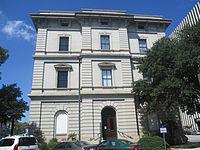
The city of Columbia has a council-manager form of government. The mayor and city council are elected every four years, with no term limits. Elections are held in the spring of even numbered years. Unlike other mayors in council-manager systems, the Columbia mayor has the power to veto ordinances passed by the council; vetoes can be overridden by a two-thirds majority of the council, which appoints a city manager to serve as chief administrative officer. Steve Gantt is the current city manager. The current mayor is a Democrat, Steve Benjamin.
The city council consists of six members (four from districts and two at-large). The city council is responsible for making policies and enacting laws, rules, and regulations in order to provide for future community and economic growth, in addition to providing the necessary support for the orderly and efficient operation of city services.
At-Large
Districts
See related article Past mayors of Columbia, South Carolina
The city's police force is the Columbia Police Department. The chief of police answers to the city manager. Presently, the chief of police is Randy Scott.
The South Carolina Department of Corrections, headquartered in Columbia, operates several correctional facilities in Columbia. They include the Broad River Correctional Institution, the Goodman Correctional Institution, the Camille Griffin Graham Correctional Institution, the Stevenson Correctional Institution, and the Campbell Pre-Release Center. Graham houses the state's female death row. The State of South Carolina execution chamber is located at Broad River. From 1990 to 1997, Broad River housed the state's male death row.
Fort Jackson is the U.S. Army's largest training post.
Under command of the South Carolina Air National Guard.
Columbia is home to the main campus of the University of South Carolina, which was chartered in 1801 as South Carolina College and in 1906 as the University of South Carolina. The university has 350 degree programs and enrolls more than 27,500 students throughout 15 degree-granting colleges and schools. It is an urban university, located in downtown Columbia.
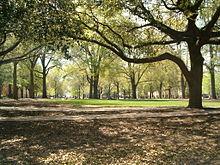
The Carnegie Foundation for the Advancement of Teaching has designated the university a research institution of "very high research activity". The school also has a world-renowned international business program, ranking number 1 in the nation for its undergraduate international business program and number 2 for its graduate international business program in the 2006 U.S. News & World Report college and graduate school guides. The University of South Carolina's University 101 program is also frequently cited by U.S. News & World Report as one of the top programs of its kind in the nation. The university is also home to the nation aos first National Science Foundation Industry/University Cooperative Research Center for Fuel Cells.
As part of a new initiative geared towards making the University of South Carolina a world-class research and technology school, the university is building Innovista, a unique "innovation district" located between the campus' core and the banks of the Congaree River. Innovista's goal is to be a standard-setting environment that draws its vibrancy from integrating public and private sector research and researchers with retail, restaurant, residential, and recreational facilities contained within a contemporary urban landscape.
Columbia is also home to:
Columbia is also the site of several extension campuses, including those for Erskine Theological Seminary, South University, and the University of Phoenix.
The Sisters of Charity Providence Hospitals is sponsored by the Sisters of Charity of Saint Augustine (CSA) Health System. The non-profit organization is licensed for 304 beds and comprises four entities: Providence Hospital, Providence Heart Institute, Providence Hospital Northeast, and Providence Orthopaedic & NeuroSpine Institute. Providence Hospital, located in downtown Columbia, was founded by the Sisters of Charity of Saint Augustine in 1938. The facility offers cardiac care through Providence Heart Institute, which is considered a quality cardiac center in South Carolina. Providence Hospital Northeast is a 46-bed community hospital established in 1999 that offers a range of medical services in surgery, emergency care, women's and children's services, and rehabilitation. Providence Northeast is home to Providence Orthopaedic & NeuroSpine Institute, which provides medical and surgical treatment of diseases and injuries of the bones, joints, and spine.
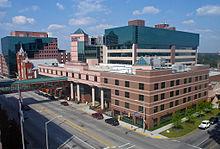
Palmetto Health is a South Carolina nonprofit public benefit corporation consisting of Palmetto Health Richland and Palmetto Health Baptist hospitals in Columbia. Palmetto Health provides health care for nearly 70 percent of the residents of Richland County and almost 55 percent of the health care for both Richland and Lexington counties. Palmetto Health Baptist recently underwent a $40 million multi-phase modernization which included 37,000 square feet (3,400 m2) of new construction and 81,000 square feet (7,500 m2) of renovations. The extensive health system also operates Palmetto Health Children's Hospital and Palmetto Health Heart Hospital, the state's first freestanding hospital dedicated solely to heart care, which opened in January 2006. The Palmetto Health South Carolina Cancer Center offers patient services at the Palmetto Health Baptist and Palmetto Health Richland campuses; both are recognized by the American College of Surgeons Commission on Cancer as a Network Cancer Program.
Lexington Medical Center is a network of hospitals aeurgent care centers that are all located throughout Lexington County, South Carolina. There are currently six urgent care centers located in Lexington, Irmo, Batesburg-Leesville, Swansea, and Gilbert. The main hospital is in West Columbia. LMC opened in 1971 but quickly grew into a large center that has been growing every year since its opening. Currently, the main center offers an array of services from emergency treatments to the upcoming heart center.
The Wm. Jennings Bryan Dorn VA Medical Center is a 216-bed facility, encompassing acute medical, surgical, psychiatric, and long-term care. The hospital provides primary, secondary, and some tertiary care. An affiliation is held with the University of South Carolina School of Medicine, located on the hospital grounds. A sharing agreement is in place with Moncrief Army Community Hospital at Fort Jackson and the 20th Medical Group at Shaw AFB in Sumter.
The Central Midlands Regional Transit Authority (CMRTA), is the agency responsible for operating mass transit in the greater Columbia area including Cayce, West Columbia, Forest Acres, Arcadia Lakes, Springdale, and the St. Andrews area. CMRTA operates express shuttles, as well as bus service serving Columbia and its immediate suburbs. The authority was established in October 2002 after SCANA released ownership of public transportation back to the City of Columbia. Since 2003, CMRTA provides transportation for more than 2 million passengers, has expanded route services, and introduced 43 new ADA accessible buses offering a safer, more comfortable means of transportation. CMRTA has also added 10 natural gas powered buses to the fleet.
The Central Midlands Council of Governments is in the process of investigating the potential for rail transit in the region. Routes into downtown Columbia originating from Camden, Newberry, and Batesburg-Leesville are in consideration, as is a potential line between Columbia and Charlotte connecting the two mainlines of the future Southeastern High Speed Rail Corridor.
Columbia's central location between the population centers of South Carolina has made it a transportation focal point with three interstate highways and one interstate spur.
The city and its surroundings are served by Columbia Metropolitan Airport (IATA:CAE; ICAO:KCAE). The airport itself is serviced by American Eagle, Delta, United Express, and US Airways Express airlines. In addition, the city is also served by the much smaller Owens Field located in the Rosewood neighborhood. It serves as the county airport for Richland County and offers general aviation.
The city is served daily by Amtrak station, with the Silver Star trains connecting Columbia with New York City, Washington, DC, Savannah, Jacksonville, Orlando, Tampa, and Miami. The station is located at 850 Pulaski St.
Greyhound Lines operates a station on Gervais Street, in the eastern part of downtown, providing Columbia with intercity bus transportation.

The city of Columbia has recently accomplished a number of urban redevelopment projects and has several more planned. The historic Congaree Vista, a 1,200-acre (5 km2) district running from the central business district toward the Congaree river, features a number of historic buildings that have been rehabilitated since its revitalization begun in the late 1980s. Of note is the adaptive reuse of the Confederate Printing Plant on Gervais and Huger, used to print Confederate bills during the American Civil War. The city cooperated with Publix grocery stores to preserve the look. This won Columbia an award from the International Downtown Association. The Vista district is also where the region's convention center and anchor Hilton hotel with a Ruth's Chris Steakhouse restaurant are located. Other notable developments under construction and recently completed include high-end condos and townhomes, hotels, and mixed-use structures.
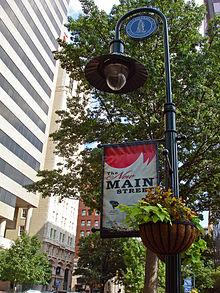
The older buildings lining the Vista's main drag, Gervais, now house art galleries, restaurants, unique shops, and professional office space. Near the end of Gervais is the South Carolina State Museum and the EdVenture Children's Museum. Private student housing and some residential projects are going up nearby; the CanalSide development at the site of the old Central Correctional Institution, is the most high profile. At full build-out, the development will have 750 residential units and provides access to Columbia's waterfront. Lady Street between Huger and Assembly streets in the Vista and the Five Points neighborhood have undergone beautification projects, which mainly consisted of replacing curbs and gutters, and adding brick-paved sidewalks and angled parking.
Special revitalization efforts are being aimed at Main Street, which began seeing an exodus of department and specialty stores in the 1990s. The goal is to re-establish Main Street as a vibrant commercial and residential corridor, and the stretch of Main Street home to most businesses ae-from Gervais to Blanding streets ae-has been streetscaped in recent years. Notable developments completed in recent years along Main Street include an 18-story, $60 million tower at the high-profile corner of Main and Gervais streets, the renovation of the 1441 Main Street office building as the new Midlands headquarters for Wells Fargo Bank (formerly Wachovia Bank), a new sanctuary for the Holy Trinity Greek Orthodox Church, and the location of Mast General store in the historic Efird's building. The relocation of the Nickelodeon theater is currently underway and a facade improvement program for the downtown business district, implemented in 2011, has resulted in the restoration and improvement of the facades of several historic Main Street shopfronts.
The Meridian building, a 17-story, $62 million office tower, was completed in 2004 and First Citizens Bank completed a $40 million, 170,000-square-foot (16,000 m2), nine-story headquarters tower at the corner of Main and Lady streets in 2006. The historic Palmetto Building, at the corner of Main and Washington streets, underwent renovations and re-opened its doors in July 2008 as a boutique, Sheraton Hotel, and directly across from it, the historic Republic National Bank Building on Washington Street was turned into meeting and banquet space for the Sheraton. On September 25, 2007, a new fountain and sculpture, located in Boyd Plaza in front of the Columbia Museum of Art at the corner of Main and Hampton streets downtown, was dedicated. The 25-foot (7.6 m) tall piece, entitled "Apollo's Cascade", was designed by famed sculptor Rodney Carroll and was commissioned using a leadership gift from the Colliers Keenan Real Estate Firm.
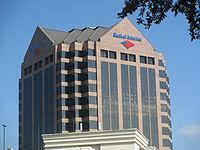
Columbia enjoys a diversified economy, with the major employers in the area being South Carolina state government, the Palmetto Health hospital system, Blue Cross Blue Shield of SC, Palmetto GBA, and the University of South Carolina. The corporate headquarters of energy company, SCANA, are located in the Columbia suburb of Cayce. Other major employers in the Columbia area include Fort Jackson, the U.S. Army's largest and most active initial entry training installation, Richland School District One, Humana/TriCare, and the United Parcel Service, which operates its Southeastern Regional Hub at the Columbia Metropolitan Airport. Major manufacturers such as Square D, CMC Steel, Spirax Sarco, Michelin, International Paper, Pirelli Cables, Honeywell, Westinghouse Electric, Harsco Track Tech, Trane, Intertape Polymer Group, Union Switch & Signal, Solectron, and Bose Corporation Technology have facilities in the Columbia area. There are over 70 foreign affiliated companies and fourteen Fortune 500 companies in the region. The gross domestic product (GDP) of the Columbia metropolitan statistical area as of 2008 was $30.08 billion, the highest among MSAs in the state.
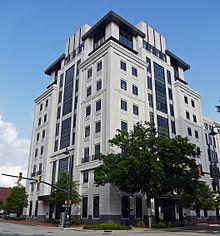
Several companies have their global, continental, or national headquarters in Columbia, including Colonial Life & Accident Insurance Company, the second-largest supplemental insurance company in the nation; the Ritedose Corporation, which provides a wide range of services to the pharmaceutical industry; AgFirst Farm Credit Bank, the largest bank headquartered in the state with over $30 billion in assets (the non-commercial bank is part of the Farm Credit System, the largest agricultural lending organization in the United States which was established by Congress in 1916); First Citizens bank, the largest state-based commercial bank; Nexsen Pruet, LLC, a multi-specialty business law firm in the Carolinas; Spectrum Medical, an international medical software company; Wilbur Smith Associates, a full-service transportation and infrastructure consulting firm; and Nelson Mullins, a major national law firm.
Many reputable publications and institutes recognize the strength and potential of the city's economy. In the Forbes 2009 "Best Places for Business and Careers" list, Columbia ranked 34th overall among the 200 large metropolitan areas ranked. A 2010 study of the best places for small businesses by Portfolio.com/Bizjournals ranked Columbia 12th of the nation's 100 largest metro areas. BusinessWeek ranked Columbia 14th on its 2009 and 2010 "Forty Strongest U.S. Metro Economies" list. Bizjournals ranked Columbia 25th of 105 medium-sized labor markets for young adult job seekers and 15th of 77 metropolitan areas in its "Jewels of the Sunbelt" ranking, which ranks cities according to "blend of comfortable lifestyle and warm weather". POLICOM, a company that specializes in studying the dynamics of local economies, placed the Columbia metropolitan region in the top 25th percentile among the 366 U.S. Census Bureau-designated metropolitan statistical areas nationwide (and first among metropolitan areas in the state) in its 2009 economic strength rankings.
As of the census of 2010, there were 129,272 people, 52,471 total households, and 22,638 families residing in the city. The population density was 928.6 people per square mile (358.5/km ²). There were 46,142 housing units at an average density of 368.5 per square mile (142.3/km ²). The racial makeup of the city was 51.27% White, 42.20% Black, 2.20% Asian, 0.25% Native American, 0.30% Pacific Islander, 1.50% from other races, and 2.00% from two or more races. Hispanic or Latino of any race were 4.30% of the population.
There were 45,666 households out of which 22.4% had children under the age of 18 living with them, 28.7% were married couples living together, 17.1% have a female householder with no husband present, and 50.4% were nonfamilies. 38.0% of all households were made up of individuals and 8.9% had someone living alone who was 65 years of age or older. The average household size was 2.18 and the average family size was 2.94.
In the city the population was spread out with 20.1% under the age of 18, 22.9% from 18 to 24, 30.1% from 25 to 44, 16.6% from 45 to 64, and 10.3% who were 65 years of age or older. The median age was 29 years. For every 100 females there were 96.2 males. For every 100 females age 18 and over, there were 93.4 males.
The median income for a household in the city was $31,141, and the median income for a family was $39,589. Males had a median income of $30,925 versus $24,679 for females. The per capita income for the city was $18,853. About 17.0% of families and 22.1% of the population were below the poverty line, including 29.7% of those under the age of 18 and 16.9% ages 65 or older.
Like most of the Southern United States which is included in the Bible Belt, Columbia's population is largely dominated by members of Protestant denominations, the largest being the Southern Baptists, followed by Methodists. The rest of the population is distributed among other Protestant denominations as well as the Roman Catholic Church. There is a significant Episcopalian population in Columbia, including Trinity Episcopal Cathedral. Columbia is the see city of the Diocese of Upper South Carolina. The Greek Orthodox Church holds a large Greek Festival annually in September. There is a temple for the Church of Jesus Christ of Latter-day Saints (Mormons). There are three synagogues in Columbia, Beth Shalom (Conservative), Tree of Life Congregation (Reform), and the Chabad Learning Shul (Orthodox), which are located within a few hundred yards of each other. There are also five mosques in the city and one Hindu temple.
Among the notable people and groups connected to Columbia are:
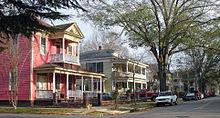
Major regional shopping centers in the Columbia area include Columbiana Centre, Columbia Place and the Village at Sandhill, along with a handful of other smaller shopping centers in the region.
The Five Points neighborhood, home to many locally owned businesses, is known as Columbia's eclectic village shopping area. The Devine Street corridor offers a variety of specialty shopping, including art and antiques, eclectic home furnishings, and men's, women's, and children's clothing. The historic Congaree Vista district downtown provides shoppers with a collection of shops filled with antiques, oriental rugs, jewelry, original artwork, hand-made furniture, and collectibles.
Columbia's daily newspaper is The State and its alternative newspapers include The Free Times, The Columbia Star, Columbia City Paper, Carolina Panorama Newspaper (www.carolinapanorama.net), and the SC Black News. Columbia Metropolitan Magazine is a bi-monthly publication about news and events in the metropolitan area. Greater Columbia Business Monthly highlights economic development, business, education, and the arts. Q-Notes, a bi-weekly newspaper serving the LGBT community and published in Charlotte, is distributed to locations in Columbia and via home delivery. Columbia is home to the headquarters and production facilities of South Carolina Educational Television and ETV Radio, the state's public television and public radio networks. Columbia is the 3rd largest TV market in South Carolina as ranked by number of households in the viewing area. The local radio stations are:
Word Count: 6789





